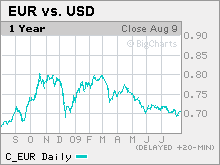Dollar falls on yen
Japanese currency rises against rivals on China's lackluster data, risk aversion.
NEW YORK (Reuters) -- The Japanese yen rose broadly Tuesday as investors bought the low-yielding currency on a U.S. stock slide, and on rising risk aversion after disappointing economic data from China.
China reported below-forecast growth in factory output and investment, reminding investors that the world's third-largest economy is not yet back on a solid footing.
The news also added to the currency woes of the so-called commodity-bloc countries that supply raw materials to China, such as Australia and Canada. The commodity-bloc currencies were among Tuesday's biggest decliners against the U.S. dollar.
The dollar traded in a tight range, swinging between gains and losses against a basket of currencies and as investors awaited a policy statement from the Federal Reserve on Wednesday and speculated whether strong U.S. data would support the currency.
U.S. jobs data last week boosted expectations for higher U.S. interest rates by early 2010, but with a Fed announcement looming some dollar investors chose to wait rather than continue to buy.
Declines in U.S. and European stocks also prompted traders to sell currencies seen as higher risk versus the dollar and the yen.
"Chinese economic news is likely playing a part in today's forex market activity," said Nick Bennenbroek, head of currency strategy at Wells Fargo Bank in New York. "And with China seen as the global economy's main growth engine during the early stages of recovery, the disappointment (with the data) is weighing on equities and on the commodity-based and emerging currencies."
Wells Fargo expects further weakness in commodity and emerging markets currencies in the near term.
In late afternoon trading in New York, the dollar was down 1.2% at ¥95.95, off an eight-week high of ¥97.79 set last week on electronic trading platform EBS. The euro was down 1.1% against the yen at ¥135.76.
Technical currency analyst James Chen at FX Solutions in Saddle River, N.J. said in a note that the move lower in euro/yen after recent sharp gains may pave the way for a further drop to near 131.00.
The Australian dollar fell 0.9% to $0.8302, while the New Zealand dollar slipped 1.1% on the day to $0.6683. The U.S. dollar rose 1.2% against the Canadian dollar to C$1.1009.
The dollar index edged lower at 79.143, swinging between 79.355 and 79.008.
"We're in consolidation mode right now as the anticipation builds for the Fed statement tomorrow afternoon," said Brian Dolan, chief currency strategist at Forex.com in Bedminster, N.J. "The Fed will acknowledge some better data but also downplay the idea that an exit strategy will start soon."
The Fed is expected to keep rates steady at 0-0.25% on Wednesday but paint a slightly brighter economic picture while dampening speculation about a rate hike. It is also likely to end its $300 billion Treasury purchases program, as scheduled.
The euro rose 0.1% to $1.4152, close to a one-week low around $1.41 hit on Monday. Traders saw support at the 40-day moving average around $1.4095.
The market showed little reaction to German consumer price inflation data and to results of a U.S. government debt auction in which the Treasury sold $37 billion in three-year notes.
Investors also brushed off the Bank of Japan's decision to keep interest rates at 0.1%. BOJ Governor Masaaki Shirakawa said he saw no risk of a deflationary spiral in Japan.
The euro hit the day's high against the Swedish crown earlier at 10.393 crowns, according to Reuters data in New York, after ratings firm Standard & Poor's cut sovereign credit ratings for Estonia and Latvia Monday.
Swedish banks are heavily exposed to the Baltic region, which is gripped by deep recession. ![]()


